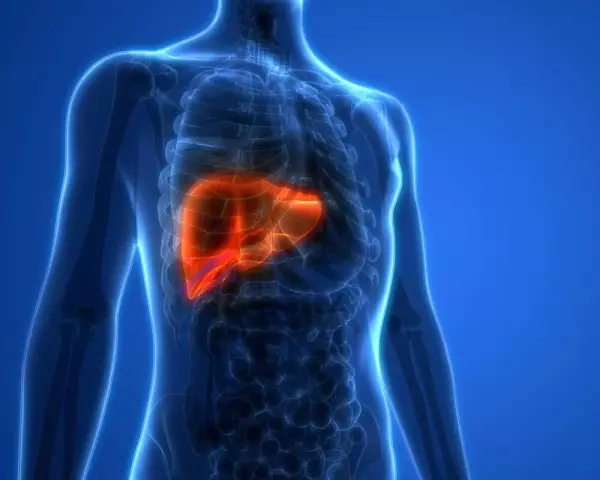- Author Rachel Wainwright [email protected].
- Public 2023-12-15 07:39.
- Last modified 2025-11-02 20:14.
Lipomatosis
The content of the article:
- Causes of lipomatosis
- Forms
- Lipomatosis symptoms
- Diagnostics
- Treatment
- Complications
- Forecast
- Prevention
Lipomatosis is a tumor-like growth of adipose tissue, which manifests itself in the form of multiple nodes in the subcutaneous tissue, intermuscular tissue.

Source: pryshhikov.ru
Lipomas, or wen, are benign, limited growths of adipose tissue in the form of yellowish nodes with a greasy sheen, developing in a loose subcutaneous layer of connective tissue. Lipoma substrate is white adipose tissue. The structure of the lipoma is identical to the structure of mature adipose tissue: it has a lobular structure, each of the lobules consists of specialized cells with high cellular activity - adipocytes, large single-drop fat cells with clear contours. In addition, the lipoma contains a certain amount of connective tissue that forms its capsule. Multiple occurrence of lipomas is referred to as lipomatosis.
Causes of lipomatosis
The etiology of lipomatosis has not been established. It is assumed that the disease is associated with the following factors:
- hereditary predisposition;
- hypofunction of the thyroid gland and pituitary gland;
- dysfunction of the endocrine system;
- pathology of the liver, kidneys, pancreas, gastrointestinal tract;
- impaired glucose absorption;
- violation of the mechanism of reverse regulation of fat formation;
- intoxication factors;
- hypodynamia;
- alcoholism.
Forms
According to the distribution, lipomatosis is classified into general and local (local).
Depending on the nature of the process, the following forms are distinguished:
- diffuse lipomatosis - characterized by the presence of diffuse, devoid of clear boundaries of growths of adipose tissue in the subcutaneous tissue, interlayers of connective tissue, parenchyma of some organs;
- nodular - differs in the formation of painful, dense, clearly limited from the surrounding subcutaneous fatty tissue of fatty nodes;
- diffusely nodular - mixed form.
There are also special forms of lipomatosis, which are determined by the characteristic superficial localization:
- hypertrophic (pseudo-athletic) lipomatosis - multiple lipomas in the shoulder girdle;
- Roche-Lery syndrome - lipomas are concentrated on the trunk and limbs (below the level of the nipples and above the knee joints);
- Madelung's lipomatosis - multiple symmetric lipomatosis, lipomas are localized in the neck in the form of a clamp;
- Verney's lipomatosis - Potena - multiple lipomas in the supraclavicular areas;
- Pasteur's lipomatosis - lipomas are placed on the lateral surface of the chest;
- Derkum's disease ("morbid obesity") - localization of lipomas in the area of the trunk, limbs, face is characteristic;
- palmar lipomatosis.
Lipomatosis symptoms
Symptoms are varied and depend on the form of lipomatosis.
Derkum's disease is the development in the subcutaneous tissue of multiple, often symmetrical lipomas or diffusely localized fatty formations that show pain.
Dercum disease symptoms:
- the appearance of pathological fatty deposits on the body and limbs, with the exception of the hands and feet;
- pain in different parts of the body;
- itchy skin;
- adynamia;
- muscle weakness, asthenia;
- reactive depressive states, hypochondria.
The disease is characterized by a chronic course with periodic exacerbations. Elderly women are more likely to get sick.
One of the variants of Dercum's disease is Gram's syndrome. The disease is characterized by a combination of obesity with deforming arthrosis of the knee joints and keratoderma.

Madelung's syndrome is characterized by excess overgrowth of adipose tissue in the neck and upper third of the trunk. Fatty growths fill the interscapular region, spread into the supraclavicular space, forming an annular (diffuse) lipoma of the neck. With a significant growth of adipose tissue, the larynx, nerve trunks, blood vessels, pharynx can be compressed. Mostly men 35-40 years old are ill.
Symptoms of Madelung lipomatosis:
- multiple symmetrical painful lipomatous nodes in the lymph nodes of the neck;
- malformations of the skeleton, dysplasia of the distal growth zone of the radius;
- breathing disorders;
- dysphagia;
- muscle weakness;
- tachycardia;
- angina pectoris;
- dysarthria;
- headaches.
Multiple Roche-Leri lipomatosis is characterized by the predominant localization of lipomas in the lower third of the body, on the upper extremities, in the groin and gluteal regions. In this case, parts of the body above the level of the nipples and below the knee joints are not affected. Fatty growths are symmetrical elastic subcutaneous formations, usually painless. The appearance of this pathology is associated with a hereditary predisposition, the disease manifests itself after 25-30 years.
If lipomatosis of the skin leads mainly only to an aesthetic defect, then the proliferation of adipose tissue in the internal organs poses a serious threat to health.
Lipomatosis of the liver - fatty infiltration of the liver. The exact mechanism of the formation of the pathology has not been clarified, however, it has been established that the deposition of adipose tissue in the liver occurs due to an abnormal increase in the level of lipids in the blood with obesity, alcohol abuse, and liver diseases. Clinically manifests itself as painful sensations in the right side, general malaise, decreased appetite, enlarged liver.
Diagnostics
To make a diagnosis, the patient is examined, anamnesis and complaints are collected, as well as additional studies, mainly in order to exclude other pathologies with similar symptoms:
- puncture of a lipoma with cytological examination of punctate;
- Ultrasound of the abdominal cavity;
- chest x-ray;
- CT or MRI.
Treatment
Lipomatosis treatment is carried out in three directions:
- surgical removal;
- pharmacological treatment;
- lifestyle correction.
The method is chosen on an individual basis, taking into account the type of disease, size and prevalence of lipomas.
The main method of treating lipomatosis is surgical excision of subcutaneous formations, although it does not exclude relapses. Superficially located small lipomas are removed using a minimally invasive method - through a small puncture using a laser or cryodestruction. This surgery is performed on an outpatient basis under local anesthesia.

Symptomatic therapy is aimed at reducing pain and combating disorders of the gastrointestinal tract. With lipomatosis caused by hypofunction of the endocrine glands, hormone replacement therapy is prescribed.
Adherence to a therapeutic diet aimed at normalizing fat metabolism will help slow the progression of the pathological process. A fractional diet is shown, a diet low in high-calorie, especially fatty and sweet foods, moderate but regular physical activity.
Complications
Lipomatosis can lead to the following complications:
- compression of vital structures;
- rupture of the lipoma into the abdominal cavity or retroperitoneal space;
- violation of blood circulation, congestion in tissues, the development of edema, venous insufficiency.
- violation of the circulation of cerebrospinal fluid;
- development of heart failure, arrhythmias.
Forecast
The prognosis for life is favorable, due to the slow development and benign course of the pathological process.
Prevention
Given the fact that in most cases lipomas develop against the background of impaired fat metabolism, its normalization seems to be the main measure for the prevention of lipomatosis. It is recommended to control body weight, if you are prone to obesity, exclude fatty, flour and sugar-containing foods from the diet, and reduce alcohol consumption.
YouTube video related to the article:

Anna Kozlova Medical journalist About the author
Education: Rostov State Medical University, specialty "General Medicine".
The information is generalized and provided for informational purposes only. At the first sign of illness, see your doctor. Self-medication is hazardous to health!






